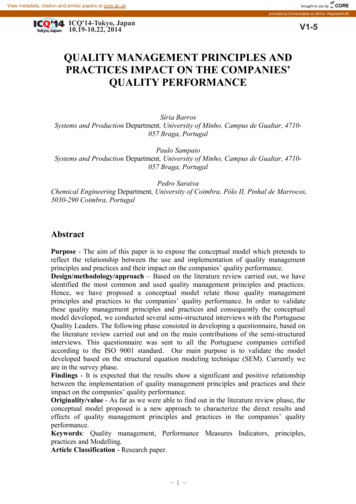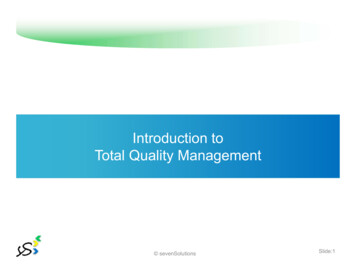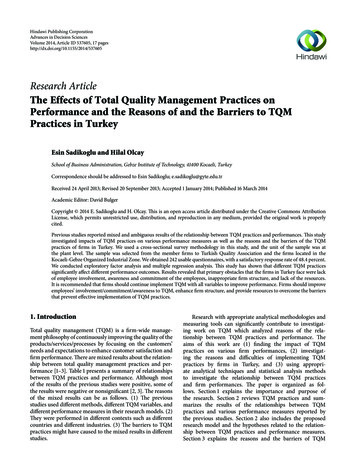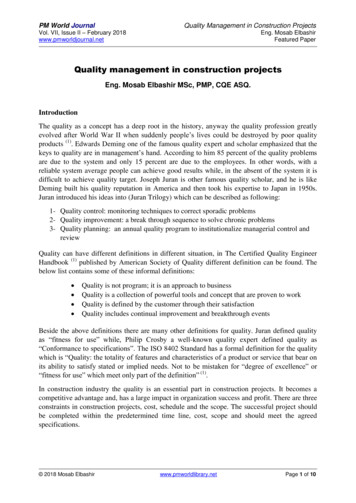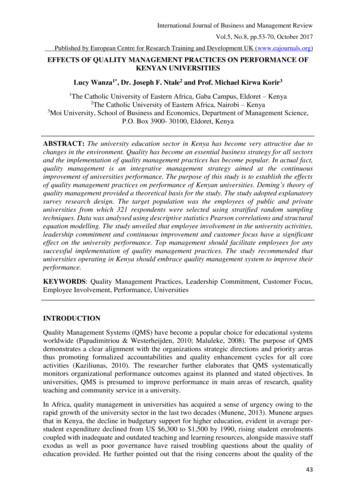
Transcription
International Journal of Business and Management ReviewVol.5, No.8, pp.53-70, October 2017Published by European Centre for Research Training and Development UK (www.eajournals.org)EFFECTS OF QUALITY MANAGEMENT PRACTICES ON PERFORMANCE OFKENYAN UNIVERSITIESLucy Wanza1*, Dr. Joseph F. Ntale2 and Prof. Michael Kirwa Korir3The Catholic University of Eastern Africa, Gaba Campus, Eldoret – Kenya2The Catholic University of Eastern Africa, Nairobi – Kenya3Moi University, School of Business and Economics, Department of Management Science,P.O. Box 3900- 30100, Eldoret, Kenya1ABSTRACT: The university education sector in Kenya has become very attractive due tochanges in the environment. Quality has become an essential business strategy for all sectorsand the implementation of quality management practices has become popular. In actual fact,quality management is an integrative management strategy aimed at the continuousimprovement of universities performance. The purpose of this study is to establish the effectsof quality management practices on performance of Kenyan universities. Deming’s theory ofquality management provided a theoretical basis for the study. The study adopted explanatorysurvey research design. The target population was the employees of public and privateuniversities from which 321 respondents were selected using stratified random samplingtechniques. Data was analysed using descriptive statistics Pearson correlations and structuralequation modelling. The study unveiled that employee involvement in the university activities,leadership commitment and continuous improvement and customer focus have a significanteffect on the university performance. Top management should facilitate employees for anysuccessful implementation of quality management practices. The study recommended thatuniversities operating in Kenya should embrace quality management system to improve theirperformance.KEYWORDS: Quality Management Practices, Leadership Commitment, Customer Focus,Employee Involvement, Performance, UniversitiesINTRODUCTIONQuality Management Systems (QMS) have become a popular choice for educational systemsworldwide (Papadimitriou & Westerheijden, 2010; Maluleke, 2008). The purpose of QMSdemonstrates a clear alignment with the organizations strategic directions and priority areasthus promoting formalized accountabilities and quality enhancement cycles for all coreactivities (Kaziliunas, 2010). The researcher further elaborates that QMS systematicallymonitors organizational performance outcomes against its planned and stated objectives. Inuniversities, QMS is presumed to improve performance in main areas of research, qualityteaching and community service in a university.In Africa, quality management in universities has acquired a sense of urgency owing to therapid growth of the university sector in the last two decades (Munene, 2013). Munene arguesthat in Kenya, the decline in budgetary support for higher education, evident in average perstudent expenditure declined from US 6,300 to 1,500 by 1990, rising student enrolmentscoupled with inadequate and outdated teaching and learning resources, alongside massive staffexodus as well as poor governance have raised troubling questions about the quality ofeducation provided. He further pointed out that the rising concerns about the quality of the43
International Journal of Business and Management ReviewVol.5, No.8, pp.53-70, October 2017Published by European Centre for Research Training and Development UK (www.eajournals.org)universities and the graduates have catalysed national educational authorities and individualinstitutions to adopt quality management practices in order to enhance the quality of education.The challenge for the top management of universities is whether adoption, implementation andeffectiveness of quality management practices have improved on universities performance isstill lacking (Osumba, 2014; Dado, Petrovicova, Riznic & Rajic, 2011). Consequently, theimpact of quality management practices on organizations performance has been the subject ofconstant interest and challenge among researchers (Ebrahimi & Sadeghi, 2013).A study by Garza-Rayes, Rocha-Lona and Kumar (2014) postulates that QMS frameworks takemany forms and descriptions ranging from Total Quality Management (TQM), BusinessExcellence Models (BEMs), self-assessment models, International Organization forStandardization (ISO) standards, Six Sigma, and Lean Manufacturing. The most commonframework adopted by universities is ISO standards. ISO 9001:2008 has eight principles(practices) namely: customer focus, continual improvement, leadership commitment,employee involvement, systematic approach, process approach, factual approach to decisionmaking and mutually beneficial supplier relationship.Like many business organizations, the survival, growth and prosperity of universities dependon how they respond to changes taking place in their particular environment. In view of this,strategic management plays a key role in positioning universities in their quest to achievesustainable competitive advantage and improve performance. Therefore, for organizations toremain truly competitive over time as the environment changes, Mathooko and Ogutu (2014)recommends that universities have to learn to adapt and reorient themselves to the changingenvironment. Quality has become one of the most important drivers of the global competitiontoday. Quality management practices (QMPs) incorporated overall organizational strategy,communicated to all employees and well implemented may have a positive impact onorganizational performance (Sigei, 2014).In Kenya, the Commission for University Education policy, the lecturer - student ratio shouldbe 1:40 (CUE, 2015). However, the study of Ongaki and Nyamiobo (2014) noted that thecurrent ratio in Kenyan public universities is up to 1:700. The researchers were of the view thathaving individualized teaching and consultation has become close to impossible in theseuniversities. The increasing number of universities and the rapidly rising student populationwith a steeply rising student academic staff ratio coupled with declining resources haveimpacted negatively on the university performance (Ongaki & Nyamiobo, 2014).Implementing quality management system (QMS) is not without difficulties and achieving itspromised benefits is not straight forward. Universities need to proactively adopt QMS in theiroperations across all internal factors in order to improve their performance (Mokamba, Oloko& Letting, 2014).Universities are good candidates of research publication, quality teachingwith a rich application of the QMS, yet their performance is still debatable and require furtherinvestigation (Posmas, Fotopoulos & Kafetzopoulos, 2010). Therefore, this study sought toinvestigate the effects of quality management practices on universities performance in Kenya.44
International Journal of Business and Management ReviewVol.5, No.8, pp.53-70, October 2017Published by European Centre for Research Training and Development UK (www.eajournals.org)LITERATURE REVIEWTheoretical PerspectivesThe study was anchored on Deming’s Theory of Quality Management. Deming’s theory ofprofound knowledge is a management philosophy grounded in systems theory. Understandingthe concepts of profound knowledge is critical to understanding Deming’s approach to quality(Deming, 1989). The system of profound knowledge is made up of four interrelated parts: (i)theory of systems (ii) theory of variations (iii) theory of knowledge and (iv) knowledge ofpsychology. The theory of systems is based on the principle that each organization is composedof a system of interrelated processes and people which make up system’s components (Deming,1989). Deming’s theory of quality management postulates that continuous improvement oforganization systems and processes advocates for customer satisfaction that leads to excellenceon organizational performance.Deming’s theory provides a profound understanding of how leaders need to involve people atall levels of the organization. Leadership commitment in a university is very important as itprovides direction. Human relations come first in Deming’s leadership thinking, and heemphasizes that leaders must understand well employee relations, treat their people fairly andrespectfully and give them good working conditions that they may use all their abilities,develop their competences, feel comfort and enjoy their jobs. Leaders should provideopportunities for cooperation, stimulate people to cooperate, and remove system factors thatmay demotivate them from working together in teams. Further, Deming’s theory stresses thatthe customer focus should be of central concern to leaders. The main objective ofimprovements is to satisfy the customer’s needs and expectations. Lastly, Deming’s theory isvaluable because Deming is clear by providing a profound understanding of what goes onduring the manufacture of any product or service (process management). To learn more aboutthe proper use of the Deming cycle (PDCA model), that is, Planning-Doing-Checking-Acting(Deming, 1986) may prove helpful for university management who need to worksystematically to create continuous improvements on universities performance.Quality Management PracticesThe notion of student-as-customer has originated within total quality management movement,which has started to gain certain popularity among academic institutions in light of fundingand management changes in higher education context. Though its basic principles, such ascustomer delight, people-based management, continuous improvement and management byfacts, have strong common sense, educational institutions have lagged behind manufacturingcounterparts in the adoption of this paradigm (Dado et al., 2011). Dado et al. further noted thatthe practices emphasized in an organization are dictated by the underlying principles that havebeen adopted in the organization. In the context of a management system standard, thesepractices are often referred to as implementation factors, implementation constructs or simplypracticesUniversities may start their journey towards excellence by installing a QMS. Kaziliunas (2010)explains that a QMS of a university is commitment to statutory obligations and regulatoryrequirements which should demonstrate clear alignment with the university’s strategicdirections and priority areas thus promoting formalized accountabilities and qualityenhancement cycles for all core activities and systematically monitors the university'sperformance outcomes against its planned and stated objectives. He further notes that QMS45
International Journal of Business and Management ReviewVol.5, No.8, pp.53-70, October 2017Published by European Centre for Research Training and Development UK (www.eajournals.org)promotes the understanding that responsibility for quality processes is embedded in the role ofeach of the university's staff members’ at all organizational levels – cultivating a culture of(top-down/bottom-up) ownership, participation and responsiveness throughout the institution.University leadership needs enthusiasm to successfully implement QMS. However, deeperanalysis of empirical studies has revealed that there is a lack of thorough understanding ofQMS philosophies and techniques among university management. There seem to be twoschools of thought that stimulated a debate that QMS universities did not differ significantlyfrom those without. Nevertheless, past researchers revealed that there were statisticallysignificant differences between education institutions which have adopted quality managementsystems and those that have not adopted (Kuncoro, 2013).ISO 9001:2008 standard is part of a whole family of ISO standards that describes the qualitymanagement system requirements (ISO 9001:2008(E). ISO 9000, according to Quazi, Hongand Meng (2002), is a family of standards and instructional guidelines for the purpose of qualitymanagement system development. The requirements of this standard are documented based oneight quality management principles. These principles are: 1) customer focus; 2) leadership; 3)involvement of people; 4) process approach; 5) system approach to management; 6) continualimprovement; 7) factual approach to decision making; and 8) mutually beneficial supplierrelationship. These principles were translated into requirements and documented as ISO9001:2008 standard requirements. Therefore, all work organizations, seeking ISO 9001: 2008certification, shall adopt these principles and be compliant with the standard requirements.However, recently there is a new standard ISO 9001:2015 whereby universities that had alreadyadopted the earlier standard are adopting the new one. For effective and efficientimplementation of a QMS by a university, these principles are inter-linked, based on a processapproach. This study focused on four quality management practices: top leadershipcommitment, employee involvement, customer focus and continual improvement.Leadership CommitmentThe top leadership commitment is very important for the successful implementation of qualitymanagement practices in an organization (Mutunga, 2013). The top leadership of a universityis the top administrators holding key top positions. For example, the Vice-Chancellor, anddeputy vice-chancellors, deans, human resource managers, among others. In a university, topmanagement provides the vision of where the organization is going with its quality efforts andcreates a cultural change within the organization. University top management is not randomlyassigned, and the quality of a university is established over many years incorporating factorssuch as an institution’s history, reputation, age and wealth (Goodall, 2009).Top leadership in a quality management system view the university in a system approachwhereby they need to support employee development, establish a multipoint communication,and customers, and use information efficiently and effectively to improve performance. Inaddition, leaders encourage employee participation in decision-making and empower theemployees. However, top management commitment and participation in quality managementpractices are the most important factors for the success of an organization (Goetsch & Davis,2010). Jaafreh and Al-abedallat (2013) explains that top leadership commitment is the mostvital factor in quality management and leading to higher performance. Ardi, Hidayatno andZagloel (2012) investigated relationships among quality dimensions in higher education inIndonesia. The study revealed the relationships among quality dimensions in university in anengineering faculty. The results showed that students’ satisfaction was positively influenced bycommitment of faculty management, the quality of course delivery, and the ease of giving46
International Journal of Business and Management ReviewVol.5, No.8, pp.53-70, October 2017Published by European Centre for Research Training and Development UK (www.eajournals.org)feedback for quality improvement. It is worth noting that top faculty management had animpact on university’s performance.In a university, the top leadership has to establish goals, quality policy and provide resourcesfor QMS implementation. Okwiri (2013) claimed that the fundamental principle of leadershipought to bring about the appropriate organizational culture and direction. While identifying thecritical factor in optimizing quality management process implementation of private highereducation, Mail, Patrikto, Suparman and Santoso (2014) confirms that leadership effectivenesshas a positive effect on organizational commitment, internal quality audits and quality culture.Leadership commitment and support is viewed as the most important principle because it is thetop leadership that drives the entire institution. In a university top leaders communicate to allemployees the importance of meeting students’ requirements. Top leaders develop andfacilitate the achievement of mission and vision of the university. The top leaders ensure thatstrategic quality objectives are developed and avail the required resources for the successfulQMS implementation. However, if resources are not available, this can lead to compromisingof university performance. Good university leadership would be linked to higher performance.Employee InvolvementQMS is the most recent, along with high involvement and the most comprehensive approachto employee performance. It is achieved when the organization’s goods and services exceedthe customer’s expectation. However, employee involvement and participation in the changeprocess increases the likelihood that it will become part of the organization’s culture. Whenimplemented successfully, QMS is also aligned closely with the overall business strategy andattempts to change the entire organization towards continuous quality improvement (Gulali etal., 2015). Deming claimed that involvement and participation of employees at all level mustto improve the quality of the current and future product or service (Talib, Rahman & Qureshi,2010).QMS practices ensure necessary training to all employees to improve their proficiencies intheir tasks. Employee involvement refers to ensuring that employees are motivated and performtheir jobs as per the required standards. Training should be given to all employees based on theresults of the training needs assessment (Goetsch & Davis, 2010). With effective training,employees know the industry and the structure of the university. In addition, effective trainingwill improve employees’ loyalty to the firm, motivation, and work performance. Employeerelations are important to promote teamwork and workforce management in the university.Some studies report that employee training is positively related to operational performance,employee performance, innovation performance, customer results, market and financialperformance (Phan et al., 2011; MacKelprang, Jayaram & Xu, 2012). However,Rungtusanatham, Forza, Filippini & Anderson (1998) equally demonstrated and foundnegative/insignificant results. This may have been a result of non-commitment of employeesto the QMS. In some cases, employees argue that QM practices are an additional responsibility,time consuming and expensive procedures difficult to implement. It is important to involve allemployees in different functional areas to ensure success of QMS implementation.Gulali et al. (2015) conducted a study on the effect of quality management system on theperformance of Maseno University in Kenya. The study established that the QMSimplementation had a strong positive impact on student enrolment and infrastructural growth.From this study the researchers were convinced that when employees are involved in the QMSimplementation process; their performance aspect improves. In universities, employees’ job47
International Journal of Business and Management ReviewVol.5, No.8, pp.53-70, October 2017Published by European Centre for Research Training and Development UK (www.eajournals.org)performance is seen to be triggered by their involvement in university programmes thatencourage compliance and ownership. For the success of QMS requires a collective effort fromeveryone within the organization. It is therefore crucial for all employees to be involved in theearly stages of the process of implementation. It is notable that organizations are faced withcompetitive demands for lower costs, higher performance and greater flexibility; as a result,they are increasingly turning to employee involvement to enhance customer loyalty,productivity and growth of the organization (Gulali et al., 2015). It is further believed that thisincreased employee involvement can lead to quicker, more responsive decisions, continuousperformance improvement, and greater employee flexibility, commitment and satisfaction. Inorder to meet university objectives, management need to emphasize on teamwork and creationof synergy in all functional areas of the university.Customer FocusKarani and Bichanga (2012) defined customer focus as the degree to which a firm continuouslysatisfies customer needs and expectations. In universities, customer focus is where the ideas ofservices to student are supported through staff coaching and development, which encouragedstudent’s preference and self-reliance (In'airat & Al-Kassem, 2014). According to Okwiri(2013), customer focus can be measured by the existence of the expected behavioural outcomesthat are consistent with universities that emphasize customer-value. In the university, customerfocus emphasizes on identifying the existence of systems to identify the customer to everyactivity, the needs of the identified customers and the processes which are used to create valuethat is passed to the identified customer. When customer expectations are met, their satisfactionwill be increased, and the market share will increase.Previous studies have found that customer focus positively affects operational performance,employee performance, customer satisfaction/results and aggregate firm performance (Phan etal., 2011). Customer-focus is a central tenet of market orientation; it is a set of beliefs that putsthe customer’s interest first but does not exclude those of all other stakeholders such as owners,managers, and employees, in order to develop a long-term profitability (Nwokah & Maclayton,2006). Customer focus enhances customer related processes that are adopted by universities tomeet customer satisfaction. The customers of universities are mainly the students among otherstakeholders. In universities, monitoring and evaluation of students’ performance is donethrough continuous assessment tests, term papers, class presentation and final examination atthe end of semester/trimester. Examinations are moderated by experienced lecturers to ensurethat they possess right course content. However, if monitoring of exams is not properly done,this may negatively affect the quality of education delivered and performance. Students’satisfaction is measured by conducting course evaluations taught by lecturers to create studentvalue and commitment to understand students’ needs. Universities have created students’forums to listen to their needs for example departmental meetings, general assembly where thestudents meet the lecturers and university administrators to discuss issues pertaining theirneeds. There are also suggestion boxes at strategic places for students to give their feedback.If the university is able to enrol and retain high numbers of students, this will improve financialperformance and increase its market share in the region. Once students are satisfied with theservices or products offered, a university is assured of future continuity. In this case theuniversity acquires a competitive edge.48
International Journal of Business and Management ReviewVol.5, No.8, pp.53-70, October 2017Published by European Centre for Research Training and Development UK (www.eajournals.org)Continual ImprovementContinuous improvement can be considered as the wheel of the organizational vehicle (Zakuanet al., 2012). Continual improvement emphasizes on existing audit processes, managementreviews of university performance, and on the improvement processes based on the results.Improvements in the university are carefully planned and implemented based on factual data,using a system of documentation. Continuous improvement is the most important part ofservices, means searching for never-ending improvements and developing processes to findnew or improved methods in the process of converting inputs into useful outputs (Sadikoglu &Zehir, 2010).Continuous improvement is based on three fundamental principles that is, customer focus,employee involvement and process involvement. For successful implementation of continuousimprovement in universities, there must be top management commitment and support to be atthe fore front. It is important to ensure that the university has a structure that supports all theactivities carried out, and encourage team work for all employees in their different functions.In order the employees to meet the set performance standards, education and training is vitalfor them. In the university there should be effective communication systems and a system forreward and recognition for the best performers. In order for universities to remain relevant andto focus on customer satisfaction for continuous improvement, universities need to focus oncurriculum development, plans for delivery of courses, and review of programmes regularlybased on market needs.The process of ISO certification represents an international consensus on good managementpractices with the aim of ensuring quality service delivery to clients. ISO certification hasbecome a widespread practice as organizations increasingly work to conform to theinternational standards. The standards place strong emphasis on process control and continuousimprovement which are some of the key characteristics that a university must possess to berecognized as a leading player (Magoha, 2008). Dumond and Johnson (2013) conducted a studyon managing university business educational quality: ISO or Association to AdvanceCollegiate Schools of Business (AACSB) at California State University in USA. The studycompared two prevalent but different approaches to quality management: the AACSBaccreditation standards and ISO 9001, a set of quality requirements developed by theInternational Organization for Standardization (ISO). For this comparison, the authorsreviewed literature in the field, including published quality standards, organization examplesdocumenting implementation of AACSB or ISO 9001 standards, and existing empiricalresearch results on the two approaches. Findings of the study showed that both qualityapproaches have their merits and followers. It seems feasible that AACSB might be able toborrow some elements from the ISO 9001 components and process to improve theiraccreditation process.Muindi (2014) confirm that service quality has spread and is currently embraced even ineducational institutions. In terms of how the employees in the organization perceive theirperformance, an ISO 9001 certified organization is more likely to be perceived by itsemployees as a high performer relative to the non-certified ones. An implication from thesefindings is that two ISO 9001 certified organizations are not necessarily the same in terms ofthe drivers of customer focused performance. Kimani, Kagira and Kendi (2011) noted thatservice quality has been linked with increased profitability and is seen as providing animportant competitive advantage by generating repeat sales, positive word of mouth feedback,customer loyalty and competitive product and service differentiation in universities. The49
International Journal of Business and Management ReviewVol.5, No.8, pp.53-70, October 2017Published by European Centre for Research Training and Development UK (www.eajournals.org)important dimensions or factors that determined service quality in Kenya universities wereadministrative quality, academic quality, programs quality, student support, and availability ofresources.RESEARCH METHODOLOGYThe study adopted explanatory cross-sectional survey research design. The target populationfor the study included all top management and heads of department from the eight selecteduniversities. The total number of the staff was 876 by the time of conducting the study fromwhich a sample size was 321 representing 36.6% of the respondents were selected. Theresearcher adopted simple random sampling techniques to select respondents from sixdepartments. The researchers collected primary data using a self-administered questionnaire.The researcher developed the measurement items to test the effect of quality managementpractices on university performance. In this study the researcher conducted factor analysis toanalyse the interrelationships among the variables of the study (Cooper & Schindler, 2015).The researcher used principle components method with varimax rotation to identify the factorswith higher loadings that were used for further analysis. Kaiser-Meyer-Olkin (KMO 0.866)measure of sampling adequacy was above the threshold of 0.5. Bartlett’s test of sphericity,which tests the overall significance of all the correlations within the correlation matrix, wassignificant (χ2 (703) 11975.702, p 0.000), indicating that it was appropriate to use the factoranalytic model on this set of data. The factor loadings for QMPs extracted three factors namely:continual improvement/customer focus, top management commitment and employeeinvolvement. The researcher observed that the questions that loaded highly on factor oneseemed to relate to continual improvement and customer focus measurement items.RESULTSDescriptive Statistics for Quality Management PracticesReliability and Descriptive Statistics for Top Leadership CommitmentThe study sought to find out the extent to which top leadership commitment have impacted onuniversity performance. Out of ten statements, three statements were deleted and not used forfurther analysis (Table 1). The Cronbach alpha for seven items of top leadership commitmentwas 0.932. Seven statements for top leadership commitment had values ranging from 0.913 to0.930. It can be concluded that the scales used in this study can be considered reliable.50
International Journal of Business and Management ReviewVol.5, No.8, pp.53-70, October 2017Published by European Centre for Research Training and Development UK (www.eajournals.org)Table 1: Top Leadership Commitment Practice in the UniversityTop management supports longterm quality improvementprocess in the universityTop management establishes aclear strategic direction of theuniversity’s futureEncourages commitment of allmajor departmental heads in thequality improvement processCommunicates often to the entireuniversity to create awareness,interest
quality management is an integrative management strategy aimed at the continuous improvement of universities performance. The purpose of this study is to establish the effects of quality management practices on performance of Kenyan universities. Deming’s theory of quality manage

